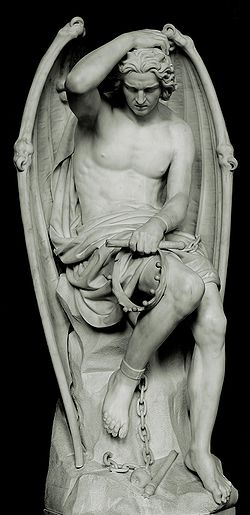Le génie du mal
| Le génie du mal | |
|---|---|
 |
|
| Artist | Guillaume Geefs |
| Year | 1848 |
| Type | white marble |
| Location | St. Paul's Cathedral, Liège |
Le génie du mal (installed 1848) or The Genius of Evil, known informally in English as Lucifer or The Lucifer of Liège, is a religious sculpture executed in white marble by the Belgian artist Guillaume Geefs. Francophone art historians most often refer to the figure as an ange déchu, a "fallen angel." It is located within the elaborate pulpit (French chaire de vérité, "seat of truth") of St. Paul's Cathedral, Liège, and depicts a classically beautiful man in his physical prime, chained, seated, and nearly nude but for drapery gathered over his thighs, his full length ensconced within a mandorla of bat wings. Geefs' work replaces an earlier sculpture created for the space by his younger brother Joseph Geefs, L'ange du mal, which was removed from the cathedral because of its distracting allure and "unhealthy beauty."
In the late 1980s, a photograph of Le génie du mal became a focal point of Himmelsweg, an art installation by the Liège-born artist on the theme of seductive evil and the danger of obscuring the memory of the Holocaust.
Le génie du mal is set within an open niche formed at the base of twin ornate staircases carved with gothic floral motifs. The curved railing of the semi-spiral stairs reiterates the arc of the wings, which are retracted and cup the body. The versions by Guillaume and Joseph are strikingly similar at first glance and appear inspired by the same human model. For each, the fallen angel sits on a rock, sheltered by his folded wings; his upper torso, arms, and legs are nude, his center-parted hair nape-length. The veined, membranous wings are articulated like a bat's, with a prominent thumb claw; the knobby, sinewy olecranon combines bat and human anatomy to create an illusion of realism. A broken sceptre and stripped-off crown are held at the right hip. The white-marble sculptures occupy approximately the same dimensions, delimited by the space; Guillaume's measures 165 by 77 by 65 cm, or nearly five-and-a-half feet in height, with Joseph's only slightly larger at 168.5 by 86 by 65.5 cm.
...
Wikipedia
